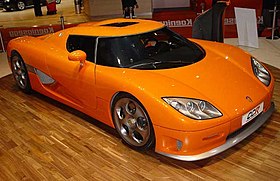Koenigsegg CCR
| Koenigsegg CCR | |
|---|---|
 | |
| Overview | |
| Manufacturer | Koenigsegg |
| Production | 2004–2006 14 built[1] |
| Assembly | Ängelholm, Sweden |
| Designer | Sven-Harry Åkesson |
| Body and chassis | |
| Class | Sports car (S) |
| Body style | 2-door Targa top |
| Layout | Rear mid-engine, rear-wheel drive |
| Powertrain | |
| Engine | 4.6 L Ford Modular V8 |
| Transmission | 6-speed manual |
| Dimensions | |
| Wheelbase | 2,659 mm (104.7 in) |
| Length | 4,191 mm (165.0 in) |
| Width | 1,989 mm (78.3 in) |
| Height | 1,069 mm (42.1 in) |
| Curb weight | 1,180 kg (2,601 lb)[2] (Dry) |
| Chronology | |
| Predecessor | Koenigsegg CC8S |
| Successor | Koenigsegg CCX |
The Koenigsegg CCR is a mid-engined sports car manufactured by Koenigsegg.
Overview
Debuting at the March 2004 Geneva Auto Show, the CCR[3] is quite similar to the CC8S and like its predecessor it features dihedral synchro-helix actuation doors. It has, however. various improvements. An upgraded body with a larger front splitter for optimized downforce, tweaked headlight arrangement and revised rear end. New larger tires and wheels equipped with larger brakes. Upgraded suspension and a more powerful engine with twin Rotrex Superchargers, producing 817 PS (601 kW; 806 hp) at 6900 rpm and 920 N⋅m (680 lb⋅ft) of torque at 5700 rpm.
To honor the Swedish Fighter Jet Squadron No. 1, (Johan röd) which had occupied the current facility of Koenigsegg, the CCR is adorned with a symbol of a ghost, the symbol of the squadron.
Performance
Manufacturer estimates.
- Acceleration: 0-100 km/h (62 mph) in 3.2 seconds
- Top speed: 388 km/h (241 mph);[4] theoretical top speed of 395+ km/h (245+ mph)
- Standing quarter mile: 9.0 seconds at 235 km/h (146 mph)
Verified.[5]
- Acceleration
- 0-60 km/h (37 mph): 2.1 seconds
- 0-80 km/h (50 mph): 3.0 seconds
- 0-100 km/h (62 mph): 3.7 seconds
- 0-120 km/h (75 mph): 4.3 seconds
- 0-140 km/h (87 mph): 5.5 seconds
- 0-160 km/h (99 mph): 6.5 seconds
- 0-180 km/h (112 mph): 7.9 seconds
- 0-200 km/h (124 mph): 9.3 seconds
- 0-220 km/h (137 mph): 11.0 seconds
- 0-240 km/h (149 mph): 13.7 seconds
- 0-260 km/h (162 mph): 16.2 seconds
- 0-300 km/h (186 mph): 24.9 seconds
- 0-1⁄4 mile: 11.2 seconds @ 224 km/h (139 mph)
Special Editions
CCR REVO
A one-off CCR which includes various improvements such as front, side and rear splitter, a new wing, and red and black ascents on the exterior and interior.
EDO Competition CCR Evolution
A German-based tuning company named EDO Competition highly modified a CCR in 2011. The company's process with the CCR began with a modified ECU to boost power and a modified drive ratio to allow the vehicle to hit its torque peak earlier. The six speed gearbox was disassembled in its entirety and the plastic bushings were replaced with Uniball units. Due to the remapped ECU and the drive ratio, power was up from 804 bhp (600 kW; 815 PS) to 891 bhp (664 kW; 903 PS) and the reduction of the redline to 7,200 rpm. As the result, the EDO Competition CCR Evolution can get from 0 to 62 mph (100 km/h) in 3.2 seconds, 0 to 124 mph (200 km/h) in 9.7 seconds, and 0 to 186 mph (299 km/h) in 23 seconds. As for the exterior, the tuner offered a new set of wheels with a coat of charcoal paint and an updated front end with auxiliary lights. The interior of the Koenigsegg was then covered in Alcantara material and a redesigned center console was added to accommodate a new infotainment system with a reversing camera and a custom-made pouch for the immobilizer remote. The display was integrated into the dashboard. The total cost for this customization kit was €40,000 or $56,428.
Speed record
At its debut, Koenigsegg claimed the CCR to be the fastest production car with a theoretical top speed of more than 395 km/h (245 mph). Said claim was put to test on February 28, 2005, at Italy's Nardò Ring where a team of five Koenigsegg engineers and mechanics together with founder Christian von Koenigsegg ran a standard CCR, driven by Loris Bicocchi to a top speed of 387.87 km/h (241.01 mph), breaking the fastest production car record that was held for 8 years by the McLaren F1. However, in April 2005, not long after the CCR claimed the record, a prototype of the long-awaited Bugatti Veyron took the crown with a top speed over 400 km/h (250 mph) with the production model reaching 408.47 km/h (253.81 mph).
References
- ^ "Koenigsegg CCR Overview". Retrieved 2011-11-02.
- ^ "Koenigsegg CCR specifications". Retrieved 2011-10-09.
- ^ "Koenigsegg CCR". DieselStation. Retrieved 17 April 2007.
- ^ Koenigsegg CCR world record run at Nardo circuit 2005
- ^ AMS Sweden — Test — Koenigsegg CCR Evolution
